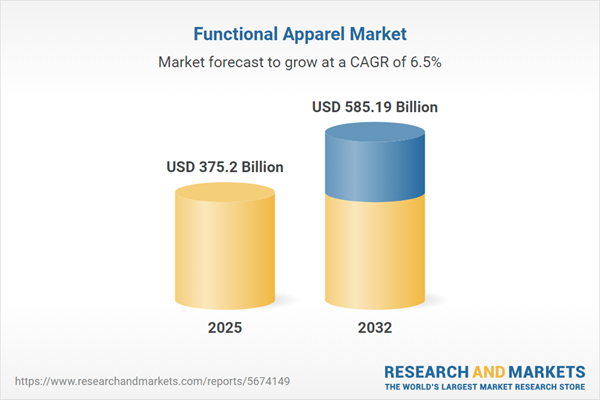Speak directly to the analyst to clarify any post sales queries you may have.
The functional apparel market is experiencing rapid transformation, driven by continuous innovation in materials technology, digitalization of sourcing and delivery, and rising demand for operational agility. Senior decision-makers must adapt to complex supply chains, competitive pressures, and evolving customer needs to maintain strong market positioning.
Market Snapshot: Functional Apparel Market Size and Growth Trajectory
The global functional apparel market is projected to grow from USD 352.29 billion in 2024 to USD 375.20 billion by 2025, and further to USD 585.19 billion by 2032. This steady expansion is powered by widespread adoption of newer functional textiles, increased use of multichannel sales, and more adaptable business models throughout the supply chain. The push for digital transformation is helping enterprises respond to regulatory demands and supply chain uncertainties, while competitive pressure is reinforcing the need for regionally tailored, customized offerings. Strategic shifts in business practice reflect an emphasis on improving market accessibility and building resilience against shifting international dynamics.
Scope & Segmentation: Functional Apparel Market
- Product Types: Medical apparel designed for healthcare safety; performance wear created for sports; protective clothing for industrial use; smart clothing embedded with sensors; durable workwear for professional settings.
- End Uses: Garments for healthcare professionals and patients, technical apparel for industrial sectors, protective solutions for military and tactical functions, and activewear for outdoor activities and sports.
- Distribution Channels: Brand-owned retail stores to enable direct purchaser engagement; mass-market retailers for wide reach; digital marketplaces that streamline procurement; specialty outlets focused on institutional and niche markets.
- Materials: Natural fibers such as cotton and wool enhance comfort and breathability; synthetic fibers increase durability and optimize performance; smart textiles offer added functions through embedded electronics.
- Gender Categories: Solutions are engineered to meet the needs of men, women, and unisex users, ensuring demographic fit and adaptability.
- Regions Covered: The Americas, Europe, Asia-Pacific, and Middle East & Africa—each with unique regulatory landscapes, sourcing strategies, and market adoption patterns influencing product development and procurement.
- Leading Companies: Major players include Nike, Inc.; adidas AG; Decathlon S.A.; VF Corporation; Lululemon Athletica Inc.; Anta Sports Products Limited; Puma SE; Under Armour, Inc.; ASICS Corporation; and Columbia Sportswear Company, distinguished for ongoing innovation and supply chain excellence.
Key Takeaways for Senior Decision-Makers
- Comprehensive digital integration across procurement, production, and logistics has streamlined market operations and improved compliance with new industry standards.
- Sustainability initiatives such as transparent sourcing and circular designs are informing capital allocation and shaping the next phase of business model innovation.
- Artificial intelligence is influencing both product design and procurement, resulting in personalized product experiences, greater market differentiation, and more engaged customers.
- Regional strategies are vital—Asia-Pacific leads in textile innovation, while Middle East & Africa prioritizes digital infrastructure to modernize operations and attract sector investment.
- Cross-departmental collaboration among sourcing, design, and compliance teams allows organizations to better anticipate regulatory shifts and swiftly adapt to evolving requirements and stakeholder expectations.
Tariff Impact and Competitive Implications
- Recent changes to U.S. tariffs on fibers and coatings have encouraged increased investment in domestic production and stronger inventory control to reduce supply chain volatility.
- Firms are placing greater importance on R&D and sustainable purchasing in response to continued regulatory evolution and the need for continuous operational agility.
- Enhanced inventory management, including bonded warehousing, is helping to maintain price stability and reliable performance, even amid complex market conditions.
Methodology & Data Sources
This analysis uses authoritative industry publications, up-to-date global regulatory sources, and patent databases. Sector insights are further supported by interviews with functional apparel professionals and C-level executives, resulting in a comprehensive overview of prevailing strategies and sector best practices.
Why This Report Matters
- Equips leadership teams with reliable guidance on integrating digital technology and sourcing diversity, helping organizations build resilience and scalable B2B growth in the functional apparel market.
- Clarifies how market segmentation and operational priorities support efficient resource deployment and more strategic executive-level decision-making.
- Frames actionable steps for embedding compliance and sustainability into everyday workflows, fostering agility as regulatory environments and stakeholder expectations shift.
Conclusion
Ongoing investment in digital solutions, collaborative operations, and agile business models is positioning companies for success as the functional apparel industry continues to evolve.
Additional Product Information:
- Purchase of this report includes 1 year online access with quarterly updates.
- This report can be updated on request. Please contact our Customer Experience team using the Ask a Question widget on our website.
Table of Contents
3. Executive Summary
4. Market Overview
7. Cumulative Impact of Artificial Intelligence 2025
Companies Mentioned
The companies profiled in this Functional Apparel market report include:- Nike, Inc.
- adidas AG
- Decathlon S.A.
- VF Corporation
- Lululemon Athletica Inc.
- Anta Sports Products Limited
- Puma SE
- Under Armour, Inc.
- ASICS Corporation
- Columbia Sportswear Company
Table Information
| Report Attribute | Details |
|---|---|
| No. of Pages | 196 |
| Published | October 2025 |
| Forecast Period | 2025 - 2032 |
| Estimated Market Value ( USD | $ 375.2 Billion |
| Forecasted Market Value ( USD | $ 585.19 Billion |
| Compound Annual Growth Rate | 6.5% |
| Regions Covered | Global |
| No. of Companies Mentioned | 11 |









